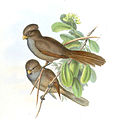| Brown parrotbill | |
|---|---|

| |
| Zuluk, Sikkim, India | |
| Conservation status | |
 Least Concern (IUCN 3.1) | |
| Scientific classification | |
| Domain: | Eukaryota |
| Kingdom: | Animalia |
| Phylum: | Chordata |
| Class: | Aves |
| Order: | Passeriformes |
| Family: | Paradoxornithidae |
| Genus: | Paradoxornis |
| Species: | P. unicolor |
| Binomial name | |
| Paradoxornis unicolor (Hodgson, 1843) | |
| Synonyms | |
|
Cholornis unicolor | |
The brown parrotbill (Paradoxornis unicolor) is a parrotbill found in the central and eastern Himalayas. It is also known as the brown suthora. This is a 17–19 cm (6.7–7.5 in) long grey-brown bird with a long tail and a characteristic small, yellowish, parrot-like bill. A dark stripe runs above the eyes and along the sides of the crown. The bird moves in small groups and will sometimes join mixed species foraging flocks. It is found in Bhutan, China, India, Myanmar, and Nepal.
Originally described by Brian Houghton Hodgson in the genus Hemirhynchus, this species was later moved to the genus Heteromorpha. It is now usually treated as a member of the family Paradoxornithidae, where its closest relative is the three-toed parrotbill. Subspecies canaster, described by Thayer and Bangs in 1912 from Hsikang, and saturatior, described by Rothschild in 1921 from Yunnan, are generally not considered valid.
Gallery
-
 At Singalila National Park, West Bengal, India
At Singalila National Park, West Bengal, India
-
 Illustration by John Gould
Illustration by John Gould
References
- BirdLife International (2016). "Cholornis unicolor". IUCN Red List of Threatened Species. 2016: e.T22716787A94510829. doi:10.2305/IUCN.UK.2016-3.RLTS.T22716787A94510829.en. Retrieved 14 November 2021.
- Grewal, Bikram; Harvey, Bill & Pfister, Otto (2014). Photographic Guide to the Birds of India: and the Indian Subcontinent, Including Pakistan, Nepal, Bhutanh, Bangladesh, Sri Lanka & the Maldives. Hong Kong: Periplus Editions. p. 495. ISBN 9781462914852.
- Rasmussen, PC & JC Anderton (2005). Birds of South Asia. The Ripley Guide. Volume 2. Washington DC and Barcelona: Smithsonian Institution and Lynx Edicions. p. 462.
- Penhallurick J & C Robson (2009). "The generic taxonomy of parrotbills (Aves, Timaliidae)" (PDF). Forktail. 25: 137–141. Archived from the original (PDF) on 2011-06-10.
- Yeung, CKL; Rong-Chien Lina; Fumin Lei; Le Man Hung; Wei Liang; F Zhou; L Hang; S-H Lia & X Yang (June 2011). "Beyond a morphological paradox: Complicated phylogenetic relationships of the parrotbills (Paradoxornithidae, Aves)". Molecular Phylogenetics and Evolution. 61 (1): 192–202. doi:10.1016/j.ympev.2011.06.004. PMID 21704175.
- Deignan HG; RA Paynter Jr. & S D Ripley (1964). Mayr, E & Paynter, R A Jr. (eds.). Check-List of Birds of the World. Volume 10. Cambridge, Massachusetts: Museum of Comparative Zoology. p. 432.
- Robson, C. (2007). Family Paradoxornithidae (Parrotbills) pp. 292 – 321 in; del Hoyo, J., Elliott, A. & Christie, D.A. eds. Handbook of the Birds of the World, Vol. 12. Picathartes to Tits and Chickadees. Lynx Edicions, Barcelona.
| Taxon identifiers | |
|---|---|
| Paradoxornis unicolor | |
| Cholornis unicolor | |
This Sylvioidea-related article is a stub. You can help Misplaced Pages by expanding it. |